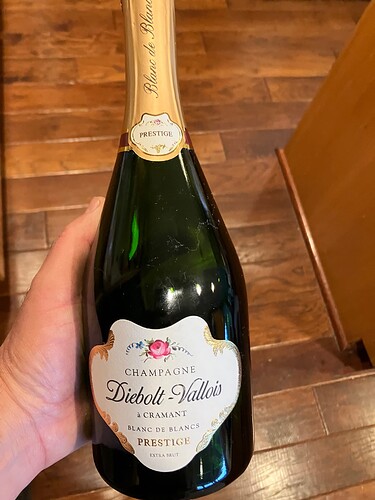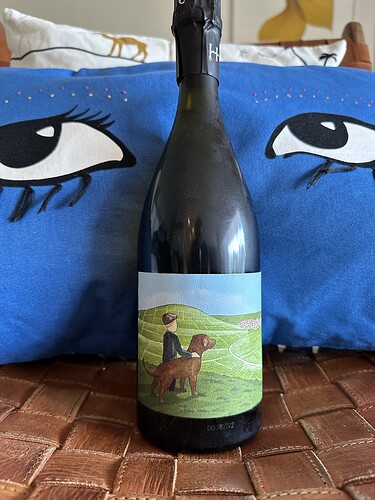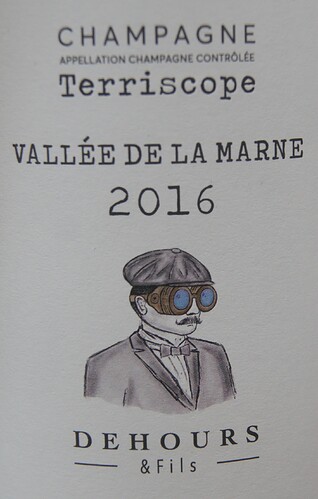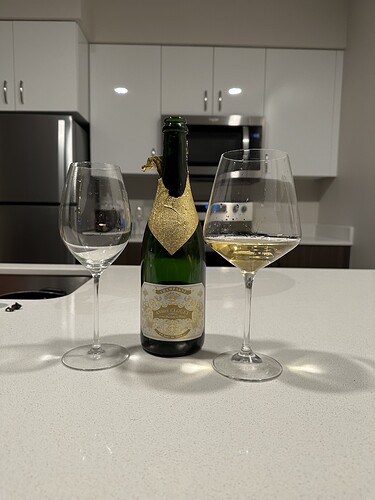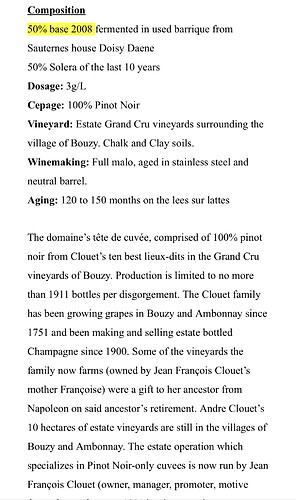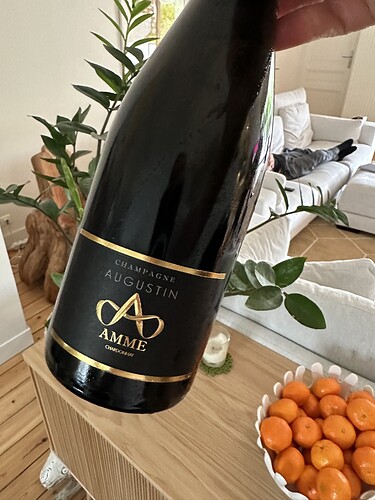I had this happen with some 99 Doquet (to be fair, I was aware of risks buying 20 year old champers). No freshness, oxidized. Total bummer.
We finished up our bottle of Diebolt Vallois BdB Brut last night and then opened a DV Prestige (60% 2017, 25% 2016, 15% perpetual reserve) for comparison. Wow, what a big step up. The Prestige was better in really every way that matters for just a moderate amount more money. At $50, this is a perfect fit for my palate and budget and I’ll have my eyes peeled for the 2019 base. Now if they could just get rid of the fat bottle.
It’s Marybeth’s birthday trip, and she wanted to visit Moulin Rouge. I have to admit, it was a fun cabaret experience (but skip the dinner option, just go to the show). Our dinner came with a bottle of Laurent Perrier Brut LP which is always good, rarely memorable, but never lets me down. We needed something else for the show, so I found this pearl on the wine list. It was priced close to stateside retail. This 2008 Charles Heidsieck Champagne Brut Millésimé Rosé was really outstanding in terms of depth and complexity. Dense brioche, red berries, citrus, flowers and spice. It has that 2008 freshness and energy.
Strong hype here, but a very nice champagne, 60:40 Chard:Meunier. March 22 disgorgement. Extra brut. A little toasty rich with some honied walnuts. I’ll wait before opening another.
Romain Henin Le Gamin du Terroir.
This 2008 Charles Heidsieck Champagne Brut Millésimé Rosé was really outstanding in terms of depth and complexity. Dense brioche, red berries, citrus, flowers and spice. It has that 2008 freshness and energy.
Thanks for the note. I loved the 05 and 06 version of this wine (still sitting on a mag of the 2006) and bought a few of this. Not as many as most of the posters in this thread would buy but - hey - I own too much wine and don’t drink much!
The new allocation form Dehours has arrived and with it the new champagne, Terriscope. The grapes are purchased and c ome from the Rive Gauche, 100% Meunier, dosage 1,1g/l from the third best vintage of the last decade, namly 2016.
Dehours after Selosse is pushing the boundaries of oxaditive champagne, this one is not for the weak hearted. The terriscope has pronounced ripeness, is powerful with for meunier really clean and articulated acidity, there are salty undetones. Reminds me a bit of a Ganevat/Marnes Blanche chardonnay, sort of the same ingwer broth aromatics. I think this will gain in complexity but with 1,1g/l better to enjoy.
Donald,
This isn’t purchased grapes, but purchased, bottled wine that Jerome disgorges and dosages. Please be correct. This is classic sur-lattes, but Dehours is very clear about this. It is a nice wine, but nothing like anything Dehours produces from his own estate and purchased grapes. As for the comparison to Selosse, I don’t get it - the two are nothing alike. While I disagree with you on the previous comments, I will say that I like a lot of what Dehours does and his Grande Reserve is currently one of the best buys in all of Champagne.
I also don’t think 2016 is the 3rd best vintage of the last decade. I’d rank 2012, 2013, 2014, 2015, 2018, and 2019 ahead of it. In some spots , 2016 is better than others, but it is still primarily an NV grade year.
I was misinformed about Dehours, but still an excellent champagne. As to vintages 13,12 and then 16.
On 18 and 19 I would say the jury is out, although for early drinking 19 is nice. Was it not Roederer, where they said 2016 reminded them of 2002.
17 from the bio-dynamic producers, really nice and suitable for short term drinking, 2017 the year the maisons messed things up and discovered the importance of good viticulture.
Donald,
On 2017, again, I would disagree, In the good locations, Bio-Dynamic producers did great, but so did organic, reasoned viticulture, and traditional producers. 2017 was all about Chardonnay and especially the Cote des Blancs. Pinot grapes were challenging especially in the Marne Valley and it was here where Bio-Dynamic producers often faired worse than reasoned viticulture producers. In very poor years, I find strict Bio-Dynamic producers face more challenges than others and the solutions are not always easy. I think 2021 was a learning experience and turning point as many sacrificed certain vineyards to save others and the overall uptick in quality showed even if the yield was low.
Anyone who had to make large production blends from 2017 was not happy and very challenged. Luckily, 2018 came about and helped things out as you could throw out a lot of 2017 crap.
A lot of research is still being done on how to be natural and fight off rot, mold, disease, etc… We are still a long way from the solution, but I hope one day we get there and can all do things in a sustainable way.
Andre Clouet Un Jour de 1911:
This is the best Champagne I have ever had. I am at a complete loss as to why I can drink this for less than $80. According to the booklet that came with the wine, this is 50% 1996 vintage, bookmarked by 25% 1995 and 25% 1997. It has, as previously noted in this thread, intense flavors of mango and apricot, as well as more subtle dried fruit notes redolent of figs, raisins, and dates. It is very creamy, slightly tannic, and somewhat austere on the finish With a lingering biscuity note. This is paradoxically intense and delicate at once. Perfect balance of maturity and freshness for my palate. I will not be cellaring my remaining bottles and I will definitely be reloading. I had high expectations and this exceeded it.
This needs to be drunk from a burgundy glass. It wasn’t nearly as open knit from the glass on the left.
I will quote Jean-Baptiste Lécaillon from Tyson Stelzer’s The champagne Guide 2020-2021. Page 30.
"Lécaillon (Louis Roederer) found the vintage to require no chaptalisation or malolactic fermentation, and comared the ripeness and acidity with the great seasons of 2012, 2002, 1964 and 1949. "At the vintage celebration at the end of harvest, I told my team that if you wanted proof that god is Champenois, this harvest was it. " he said.
I am not in the business of declaring vintages with the consequences of backing myself into a corner, something I believe critics do to often and then have great problems admitting they were wrong, or the released wines or champagnes do not standardise themselves to the critics prognosis.
I prefer to taste the finished products and base judgements on that basis. 16s are slow in coming on to the market but they are starting to trickle through. They are not champagnes with instant appeal and need time. Recent tasting of Agrapart’s 2016 Mineral and 2016 Avizoise were impressive. Brochet’s 2016 Mon benoit was difficult to read in the beginning but is now coming around.
Donald,
Roederer did good work in 2016 - better than most, but Roederer has done great work and has been better than most in just about every vintage lately. They are at the top of their game with smart decision making and investments. I also think you are taking Jean-Baptiste’s comments out of context. 2016 looked like it was going to be a very poor year, but the last 4-6 weeks were pretty much perfect for the grapes and saved the year. A sprint to the finish that brought in grapes that were far better than anyone could have imagined. Comments can be made in reference to other vintages without meaning that one is similar in quality to another. If 2016 winds up being the 3rd best vintage of the 2010s then the sky is falling in Champagne.
One last comment about 2016 - when the highest production and most well known prestige cuvee in Champagne isn’t releasing a wine from the vintage that says something about the overall quality and uniqueness of the vintage as a whole. There will of course be many wonderful smaller production wines and wines of place, but 2016 is NV quality in my book.
*edited to add in the last 5 lines of the 1st paragraph
intense flavors of mango and apricot
Glad to see your notes line up with mine.
How long have you been holding this one? Mine was a recent purchase and featured different base years. I don’t think it matters, it is such a great bottling.
Andre Clouet Un Jour de 1911:
I’ve also been enjoying this from the $55 stash I bought. I wonder how they get exactly 1911 bottles each release—where do other bottles go? And why so widely available if only 1911 bottles exist? Agree that it’s super.
According to the booklet that came with the wine, this is 50% 1996 vintage, bookmarked by 25% 1995 and 25% 1997.
fan of this wine too, but that booklet is just stock for some reason. The actual cuvee # should be written on it though. If you search back through I successfully emailed them for the actual info about a particular cuvee. Mine had the same 1996 base printed on the sheet but when I emailed them it was mostly 2008.
Here’s the link
2017 Antoine Bouvet Champagne Les Monts de la Vallée - France, Champagne (2/24/2022) 2017 Antoine Bouvet Les Monts de La Vallee - long time coming, but first pass at this producer. 100% Pinot noir from the vineyards of Avenay Val d’Or and Mareuil sur ay. disgorged 8Feb21 with 2 g/l dosage. Ripe red apple, a bit of nuttiness underneath, lemon candy. It’s all fruit on the finish, I’m going to definitely grab some more of this and will be trying the other cuvées shortly to see if the experience…
I think they theoretically can make as many cuvées as they wish, it’s just that each one is only 1911 bottles. I don’t get the impression that’s it’s per year or anything. Make 1911 bottles and then move on to the next blend (cuvee) when needed?
When you buy these you must ask the retailer to include the sheet so you can get the cuvee #. At a minimum I ask them to send me a picture of it.
Brad,
I guess we are again at an impasse with our divergent opinions. 2017 is written off as a bad year, yet we sell with 100% conviction that the champagnes we have are very good and customers rebuy.
At a tasting last year David Leclapart’s L’Aphrodisiaque from 2017 was miles ahead of the iconic 2014 Cristal. Seldom, in the group tasting was the verdict unaminous.
2016, the 744 from Jacquesson was challenging in a positive way. Dehours Terriscope a fantastic champagne.
I am sorry but I just don’t buy into this capability wine critics and wine journalists seem to have, make sweeping comments about so complex a subject.
Scott, for what it’s worth, there was an offer on this from B-21 the day before yesterday for $56, with a minimum buy of 4 bottles. There was no mention to @Robert_M_yers point about cuvee # so I am unsure as to what it may be. The wines had an ETA of July 2023.
